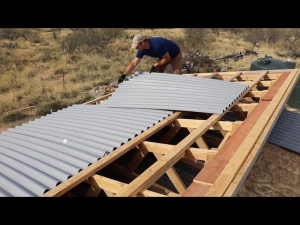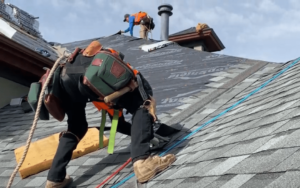Roof Repair Columbus GA is a demanding and highly skilled form of construction. A roofer must be able to communicate well with customers, negotiate shrewdly with suppliers and oversee multiple projects at once.
The first thing a roofer does is rip off the old shingles and underlayment paper, which is also called tar paper. Then they carry new material and shingle bundles to the roof using a ladder or a machine such as a boom lift or telehandler.

The roofing material used to cover a building’s structure plays a key role in its weather resistance and energy efficiency. High-quality materials not only protect against the elements but also enhance air quality inside, reducing mildew and mould growth and keeping moisture out. These qualities, in turn, help to keep indoor temperatures more stable and comfortable, lowering energy bills in the process.
While traditional roofs are made of natural products, such as thatch, slate, or tiles, today’s roofs can be constructed from a wide variety of products. Choosing the right roof material for your home depends on your aesthetic preferences, climate needs and budget.
Asphalt shingles are popular for their durability and affordability. They come in many styles and colours to match a range of architectural designs. Some are even designed to resemble other roofing materials, such as cedar shakes or slate.
Metal roofs are strong and long-lasting. They can withstand severe weather conditions, including hail and wind-driven snow. They require less maintenance than shingle or tile roofs and are easier to install on flat roofs.
Composite slate and shake roofs are a newer option that combines synthetic polymer and recycled materials with authentic slate or cedar shingles for an attractive, natural look that’s easy to maintain. They’re not suitable for locations with wildfire risks, however.
Flat-roofing materials include EPDM membrane, thermo-polyolefin (TPO), and PVC. These single-membrane systems are commonly used on commercial buildings and last 10-15 years.
Slope
The slope, or pitch, of a roof is a key aspect that influences its functionality and appearance. Whether you’re a builder or homeowner, understanding the basics of roof slope calculation can help you make informed decisions that improve your home’s performance and longevity.
The most important function of a roof is water shedding, and a steeper slope promotes faster runoff, reducing the chance of water pooling on the surface or leaking through the roofing materials. This is particularly important in areas prone to heavy rainfall, where a proper roof slope can protect your home from structural damage and other complications.
A properly sloped roof also sheds snow and ice more effectively, preventing the formation of ice dams that can block drainage and lead to leaks and other weather-related damage. Moreover, a roof with a slope that’s appropriate for your climate can help you save on energy costs by lowering the amount of heat or cool air that needs to be vented into the interior.
In addition to ensuring efficient water drainage and facilitating the use of certain roofing materials, a suitable roof slope can contribute to the architectural aesthetic of your home or building. Steep roofs, for instance, can provide a dramatic look and feel to Gothic or Tudor-style buildings, while low-slope roofs can create a modern, sleek design.
Luckily, it’s easy to determine the slope of a roof using simple tools and techniques. The most basic method involves measuring the rise and run of a roof, then dividing the vertical rise by the horizontal run to calculate the slope ratio. Alternatively, you can use a roofing calculator or a smartphone app designed to measure the angle of a roof.
Underlayment
An underlayment is a paper-like material placed on the roof deck that serves several purposes. It protects the deck from moisture and can help prevent leaks under the shingles. It also acts as a barrier against the shingle’s resin and offers some fire resistance. It’s important to choose an underlayment that works with the type of roof you have. A metal roof will do well with a synthetic underlayment, whereas an asphalt shingle roof will require a traditional roofing felt underlayment.
It helps prevent “picture framing.” Picture framing is a condition that occurs when the wood panels used for the roof deck move, creating ridges or bumps in the roof surface. This can look unattractive and it can interfere with the roof’s water-shedding function. It’s best to install underlayment as soon as possible after construction to avoid this problem.
A good underlayment will help you save money in the long run by protecting your floor covering from moisture and preventing mold, mildew, and other problems that can damage it. It can also make your flooring more comfortable by providing a soft, padded layer of cushioning. The underlayment is usually made of a hard or soft material, depending on the subfloor and flooring you have chosen. Some popular choices include cork, foam, and cement board.
If you’re interested in adding hardwood floors to your home, underlayment is a necessary step to ensure the longevity of your flooring and to protect your investment. A high-quality underlayment will prevent squeaks and cracking, trap heat to reduce energy costs, and dampen sound to make your home more relaxing. It can even offer protection against fungi, mold, and mildew.
Flashing
Flashings are thin pieces of metal that prevent water penetration around the edges and openings of a structure. They’re installed in walls, roofs, chimneys, vent pipes and wall/roof intersections to reduce indoor moisture, decrease mold problems and improve building durability. They can be made of lead, galvanized steel or copper, and are typically covered by shingles.
Roofing professionals install flashing wherever the roof plane meets a vertical surface like a wall or dormer. The flashing tucks under what’s above it and over what’s below, with enough overlap to ensure that water is directed away from the wall or roof and into the gutter system where it belongs.
There are several types of flashing, and the most common type is step flashing. It consists of sheet metal that’s layered in “steps” with the lowermost layer extending over the gutter. It’s often used in places where the roof meets a dormer or skylight, for example, and it redirects any leaks into the gutter so that rainwater doesn’t penetrate the underlayment or rot the wood framing of a house.
Another important type of flashing is valley flashing, which runs along the slope of a roof’s valley and prevents water from seeping into the roofplane where it could damage the underlayment or rot the trusses. It can be installed either as open flashing, where the metal is exposed, or closed flashing, where it’s covered by shingles.
Finally, there’s eave flashing, which is a small piece of metal at the edge of a shingle roof that protects the underlayment from rain and snow. To install it, you’ll need a custom piece of step flashing that’s cut to match the peak of the roof and then bent into place. A ridge shingle is then placed over the flashing and secured with roofing cement or caulk.
Shingles
The shingles of your roof are what protects the structure and integrity of your home by providing a barrier that repels rain, snow, hail, and other weather elements. Shingles are small overlapping pieces of material that are laid in rows or courses to cover the entire surface of your roof. They form a surface that sheds water and other precipitation through a layering process to the gutter system of your roof.
There are a few different types of shingle materials used in roofing, including asphalt, wood, clay, slate, and composite. The shingle style you choose will depend on your aesthetic preference and budget.
Asphalt shingles are the most common type of shingle for residential roofing. They are designed to last up to 30 years and come in a variety of colors and styles. There are three basic types of asphalt shingles: 3-Tab, Dimensional, and Architectural.
Dimensional shingles have two layers of shingle material and are more durable than 3-tab shingles. They have an attractive look that enhances the aesthetic of your roof. They also feature a pattern of alternating areas or tabs of single and double layers, known as the dragon tooth design. The intermittent shadow line of darker granules on the single-layer areas creates depth and dimension to your roof.
There are also designer shingles that are manufactured to replicate the appearance of other roofing materials like shakes, slate, and clay tile. These shingles are less expensive than other premium roofing materials and have a lifespan of up to 50 years. There are also eco-friendly shingle options available, such as rubber shingles and those made from recycled materials. These shingles are lighter and can help reduce energy costs.
